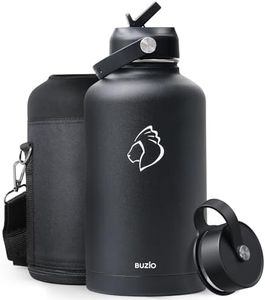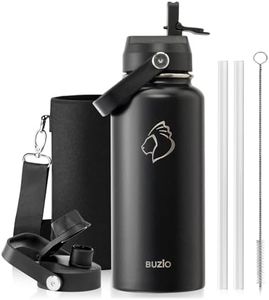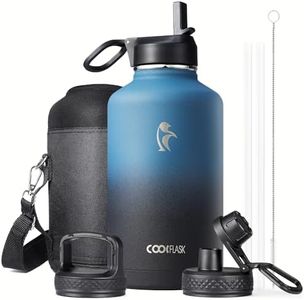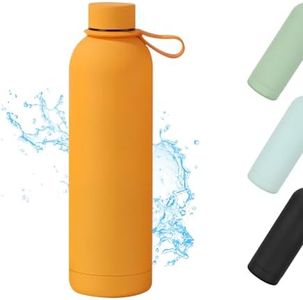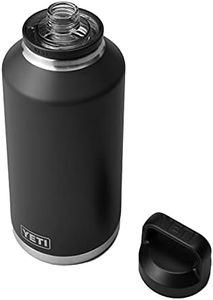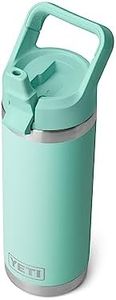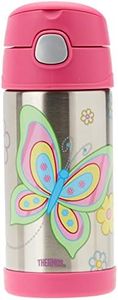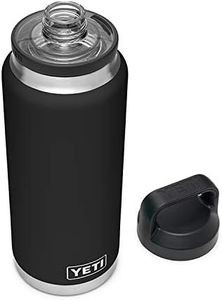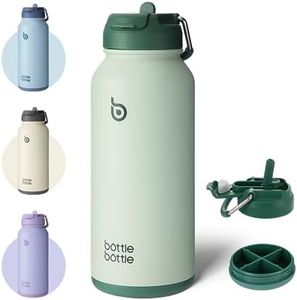We Use CookiesWe use cookies to enhance the security, performance,
functionality and for analytical and promotional activities. By continuing to browse this site you
are agreeing to our privacy policy
10 Best Cold Water Bottles
From leading brands and best sellers available on the web.Buying Guide for the Best Cold Water Bottles
Choosing the right cold-water bottle can make a big difference in your daily hydration habits. When picking a bottle, you should think about where and how often you’ll use it—at the gym, during travel, in the office, or for outdoor adventures. It’s important to find a bottle that’s convenient to carry, keeps your water cold as long as you want, and is easy to use and clean. Understanding the main features can help you make a choice that fits your routine and lifestyle.CapacityCapacity refers to how much liquid the bottle can hold, usually measured in milliliters (ml) or ounces (oz). This is important because the right size will ensure you have enough water to stay hydrated without making the bottle unnecessarily bulky and heavy. Small bottles (around 350-500 ml) are compact and great for quick trips or for kids, while medium sizes (around 600-750 ml) suit most people for daily use. Larger bottles (1 liter or more) are ideal for long hikes or if you don’t want to refill often. How much water you normally drink and where you’re taking your bottle should guide your choice here—pick a smaller one for portability or a larger one for longer outings.
InsulationInsulation indicates how well the bottle keeps drinks cold over time. Simple, single-wall bottles do not keep water cold for long but are lighter and cheaper. Double-wall insulated bottles use a vacuum layer to keep water cold for many hours—even up to a whole day. If you want your water to stay cold during hot weather or over long periods, look for double-wall insulation. For short tasks or indoor use, a non-insulated bottle might be enough. Think about how long you need your drink to stay cold and whether you’ll often be in hotter environments.
MaterialThe main materials for cold-water bottles are stainless steel, plastic, and sometimes glass. Stainless steel is sturdy, usually insulated, and won’t absorb flavors or odors—ideal for durability and repeated use. Plastic bottles are lightweight and usually less expensive, but they can hold onto flavors and may not be as cool-keeping. Glass bottles are great for avoiding any plastic taste but are heavier and more fragile. Your activities matter—choose stainless steel for outdoor or tough use, plastic for lightweight convenience, and glass for office or home where breakage is less likely.
Mouth OpeningThe mouth opening is the size of the top opening where you drink and fill your bottle. Wide-mouth bottles make it easier to add ice cubes and clean inside, but can be trickier to drink from on the move. Narrow mouthpieces are easier for sipping without spills, especially while moving, but can be harder to clean or fill with ice. Consider what’s most practical for your needs: wide mouths for easy cleaning and maximum coldness retention with ice, narrow ones for easy direct drinking.
Ease of CleaningEase of cleaning refers to how simple it is to wash out your bottle properly. Bottles with wide mouths, fewer small parts, and dishwasher-safe materials are generally much easier to keep clean. Some insulated bottles or those with complex lids may require special brushes. If you want to refill with different drinks or use your bottle frequently, a design that is easy to clean will save you effort and keep your water tasting fresh.
Lid Design and Leak ProofingLid design affects both convenience and leak protection. Some bottles have screw-on lids, flip tops, or built-in spouts and straws. Leak-proof models are crucial if you’ll carry your bottle in a bag. Consider whether you prefer easy one-handed drinking or maximum leak protection. If you move around a lot, make sure the lid closes tightly and is secure; if you mostly use your bottle at your desk, a simple lid might be enough.
Weight and ShapeThe weight and shape of the bottle impact how comfortable it is to carry and use. Heavier, insulated bottles give longer cooling but can be bulky; lightweight bottles are easier to carry but may offer less insulation. Bottles with ergonomic shapes or handles are simpler to grip and fit better in cup holders or backpack pockets. Think about how much you’ll be carrying the bottle by hand and where you’ll want to store it during your day.

